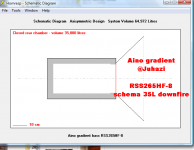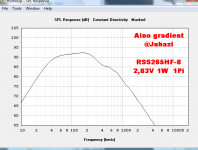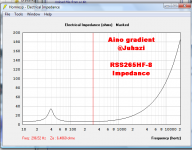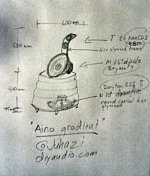Ok folks, inspired by the discussions of room acoustics, sound perception and boundary reflections here at diyaudio.com, I hereby start a new thread for a collaboratory speaker project named
Aino gradient
The inspiration to this project is the legendary and revolutionary home stereo speaker by designer Jorma Salmi, the Gradient 1.0 and it's siblings.
History
We will discuss it's design principles and we try to reconstruct and perhaps even go beyond it's performance and sound quality in contemporary domestic room environment.
This is not a commercial project and if we break some patented or otherwise protected things/issues, it is not intential.
The name of the project combines the very popular finnish first name for women (also wife of composer Jean Sibelius) and the concept of sound pressure gradient Sound speed gradient - Wikipedia, the free encyclopedia
The guidelines for development are as follows:
- to create a pair of stereo speakers that makes use of laws of physics, specially room acoustics to:
- minimize the early reflections from boundaries and to
- utilize the floor boundary gain by
- combining controlled directivity and controlled reflections
The means to achieve this are guidelined by the innovative pioneering work of Jorma Salmi, and they are mainly these:
- the bass utilizes a down-firing driver
- the mid is a large dipole tilted upwards
- the tweeter has controlled and quite narrow directivity (cascaded line array), perhaps dipole/bipole radiation
Ladies and gentlemen, start your engines!
Juhazi
Aino gradient
The inspiration to this project is the legendary and revolutionary home stereo speaker by designer Jorma Salmi, the Gradient 1.0 and it's siblings.
History
We will discuss it's design principles and we try to reconstruct and perhaps even go beyond it's performance and sound quality in contemporary domestic room environment.
This is not a commercial project and if we break some patented or otherwise protected things/issues, it is not intential.
The name of the project combines the very popular finnish first name for women (also wife of composer Jean Sibelius) and the concept of sound pressure gradient Sound speed gradient - Wikipedia, the free encyclopedia
The guidelines for development are as follows:
- to create a pair of stereo speakers that makes use of laws of physics, specially room acoustics to:
- minimize the early reflections from boundaries and to
- utilize the floor boundary gain by
- combining controlled directivity and controlled reflections
The means to achieve this are guidelined by the innovative pioneering work of Jorma Salmi, and they are mainly these:
- the bass utilizes a down-firing driver
- the mid is a large dipole tilted upwards
- the tweeter has controlled and quite narrow directivity (cascaded line array), perhaps dipole/bipole radiation
Ladies and gentlemen, start your engines!
Juhazi
For boundary gain and minimizing of early reflections it doesn't make much difference whether you have the bass down-firing or just close to the floor. Side-firing would allow different principles like cardioid and dipole - even with the choice to rotate the directivity axis.- minimize the early reflections from boundaries and to
- utilize the floor boundary gain by
- combining controlled directivity and controlled reflections
The means to achieve this ... are mainly these:
- the bass utilizes a down-firing driver
...
To my mind down-firing is only useful if you are looking for a sort of bandpass behaviour.
Rudolf
Ok, and now some concretia..
Using a minidsp give us more possibitities of usable drivers and we can also use passive components too.
The bass bin could be a closed box of some 30L and the driver Dayton RSS315HF-8 Dayton Audio RSS315HFA-8 12" Reference HF Subwoofer 8 Ohm - Subwoofers - Loudspeaker Drivers By Type - Loudspeaker Components. The lowest end should be pushed up in the xo (minidsp) The original was a br box but I like the closed better for impulse and phase behaviour. The boost might be minimal due to floor gain
The dipole mid should be a 15" which has clean midrange, minimal breakups and a light cone. Cone flexing at high frequencies is an advantage here! Perhaps some JBL pro or Beyma 15LW30 http://profesional.beyma.com/ingles/pdf/15LW30.pdf
The tweeter line of the grandmother has four 2" -2,5" paper cones, but perhaps it is wiser to make a 4-way using a supertweeter? four 2,5" cones with a cascaded LP and OW1? Peerless has many options Full Range | Tymphany
The xo frequencies and filter types give the grain of salt here. Matching the real acoustic properties and transition zones between the segments is the key to good sound. There is some theoretical and practical info but experiments and listening tests are of crucial importance here.
Using a minidsp give us more possibitities of usable drivers and we can also use passive components too.
The bass bin could be a closed box of some 30L and the driver Dayton RSS315HF-8 Dayton Audio RSS315HFA-8 12" Reference HF Subwoofer 8 Ohm - Subwoofers - Loudspeaker Drivers By Type - Loudspeaker Components. The lowest end should be pushed up in the xo (minidsp) The original was a br box but I like the closed better for impulse and phase behaviour. The boost might be minimal due to floor gain
The dipole mid should be a 15" which has clean midrange, minimal breakups and a light cone. Cone flexing at high frequencies is an advantage here! Perhaps some JBL pro or Beyma 15LW30 http://profesional.beyma.com/ingles/pdf/15LW30.pdf
The tweeter line of the grandmother has four 2" -2,5" paper cones, but perhaps it is wiser to make a 4-way using a supertweeter? four 2,5" cones with a cascaded LP and OW1? Peerless has many options Full Range | Tymphany
The xo frequencies and filter types give the grain of salt here. Matching the real acoustic properties and transition zones between the segments is the key to good sound. There is some theoretical and practical info but experiments and listening tests are of crucial importance here.
Like Rudolf - I think that the:
"- utilize the floor boundary gain by
- combining controlled directivity and controlled reflections"
-is a not a helpful design choice with respect to minimizing the effects of the room.
I think in the case of the gradient design that it was an easier method under a passive crossover system in a small form-factor to get the sort of freq. response they wanted.
IMO, when considering the use of a minidsp, you should "ditch" many of the ideas behind the Gradient 1.0 and look to super-cardioids.
Here is an idea of the effect:
Duran-Audio shows off super directional cardioid speakers - YouTube
"- utilize the floor boundary gain by
- combining controlled directivity and controlled reflections"
-is a not a helpful design choice with respect to minimizing the effects of the room.
I think in the case of the gradient design that it was an easier method under a passive crossover system in a small form-factor to get the sort of freq. response they wanted.
IMO, when considering the use of a minidsp, you should "ditch" many of the ideas behind the Gradient 1.0 and look to super-cardioids.
Here is an idea of the effect:
Duran-Audio shows off super directional cardioid speakers - YouTube
Last edited:
The dipole mid should be a 15" which has clean midrange, minimal breakups and a light cone. Cone flexing at high frequencies is an advantage here! Perhaps some JBL pro or Beyma 15LW30 http://profesional.beyma.com/ingles/pdf/15LW30.pdf
I say - take a big Pro coaxial, put it bare on the floor, tilt it towards listener, if You like it more this way, then equalize, and BABAM! - this is it
or at least very likely it may be
read this: Experience 2
Last edited:
The Vifa TC7FD00-04 should make a superb line with respect to "front + rear" arrays with the rear array adjusted to increase directivity of the frontal array via the minidsp.
Zaph|Audio
Zaph|Audio
Aino gradient
Aino, great name ! Something deeply Finnish
An externally hosted image should be here but it was not working when we last tested it.
The guidelines for development are as follows:
- to create a pair of stereo speakers that makes use of laws of physics, specially room acoustics to:
I take a small objection here, why not make three speakers ? Eventually you could try linear stereo matrix
The dipole mid should be a 15" which has clean midrange, minimal breakups and a light cone. Cone flexing at high frequencies is an advantage here! Perhaps some JBL pro or Beyma 15LW30 http://profesional.beyma.com/ingles/pdf/15LW30.pdf
If you want to keep Beyma, try MI series, they have good looking 15" mid drivers.
Even lighter cone Mms only 62g and high Qts for dipole could try cheaper alternative Celestion TF1520
LF Pressed Chassis / Ferrite - TF1520 - Celestion - Guitar, Bass & Pro Audio Speakers
The tweeter line of the grandmother has four 2" -2,5" paper cones, but perhaps it is wiser to make a 4-way using a supertweeter? four 2,5" cones with a cascaded LP and OW1?
Or even line of ribbons. Nowadays there are many alternatives, not like 30 years ago.
Have fun !
- Elias
Found this interesting as well,
Whispering at Long Distance and directional audio.mp4 - YouTube
How about a SEOS high end with line array mids?, Ive made a sketchup image,
Search sketchup for "SEOS"
Whispering at Long Distance and directional audio.mp4 - YouTube
How about a SEOS high end with line array mids?, Ive made a sketchup image,
Search sketchup for "SEOS"
Nice comments, thank you!
I must say that I fancy the looks of G1.3 a lot! The looks is also an important factor to me. That's why downfiring oval shaped bass box, open 15" and a tweeter line. I might not get the best possible sound an definitely not the easiest way, but...
Things to concider:
- a coaxial 15"
- ribbon tweeters with waveguide and open back (RAAL are too expensive, what else)
These will sit in my living room and a pair is the only possible setup. There is a 42" plasma tv on a cabinet that holds AV amp etc. Other speakers for 5.1 are small 2-ways and a diy-sub.
I must say that I fancy the looks of G1.3 a lot! The looks is also an important factor to me. That's why downfiring oval shaped bass box, open 15" and a tweeter line. I might not get the best possible sound an definitely not the easiest way, but...
Things to concider:
- a coaxial 15"
- ribbon tweeters with waveguide and open back (RAAL are too expensive, what else)
These will sit in my living room and a pair is the only possible setup. There is a 42" plasma tv on a cabinet that holds AV amp etc. Other speakers for 5.1 are small 2-ways and a diy-sub.
Since I'm the OP, I give some light of "Aino"
Aino is the most popular Finnish first name for women, it is also a purely finnish name
The popularity of Aino comes to a great deal from the national saga Kalevala. In the saga men are struggling to get young Aino's hand. The painting that Elias show is the "Triptyke of Aino" by Axel Gallén-Kallela
My youngest daughter is Aino and so was my late grandmother. My grandparents built a big house in the 30's and it was named "Ainola"
Composer Jean Sibelius' wife was Aino and they lived in a house called Ainola. My grandpa played Sibelius' violin pieces too to his Aino at his Ainola. We still have this violin and my Aino is a 9 years old violin student!
Aino Ackté was a world-famous opera singer and the inspiration to Hergé's Mme Bianca Castafiore. Ackte sung Salomé at Metropolitan Opera and made many recordings
Architect Alvar Aalto was married to designer Aino. Many of her glassware are still in production.
Aino is the most popular Finnish first name for women, it is also a purely finnish name
The popularity of Aino comes to a great deal from the national saga Kalevala. In the saga men are struggling to get young Aino's hand. The painting that Elias show is the "Triptyke of Aino" by Axel Gallén-Kallela
My youngest daughter is Aino and so was my late grandmother. My grandparents built a big house in the 30's and it was named "Ainola"
Composer Jean Sibelius' wife was Aino and they lived in a house called Ainola. My grandpa played Sibelius' violin pieces too to his Aino at his Ainola. We still have this violin and my Aino is a 9 years old violin student!
Aino Ackté was a world-famous opera singer and the inspiration to Hergé's Mme Bianca Castafiore. Ackte sung Salomé at Metropolitan Opera and made many recordings
Architect Alvar Aalto was married to designer Aino. Many of her glassware are still in production.
The form of the bass box could be oval cardioid like G1.3 or perhaps a round cardioid inspired by a glass designed by Aino Aalto, the Aino glass, just put upside down...
As you can see in the link below, the Aalto's lived for a while in my present home town Jyväskylä. Alvar was a student of Jyväskylän Lyseo, like my father and two of my daughters.
Jyväskylä is also the home of Finnish birch plywood. Alvar Aalto was the master of using laminated birch in furniture design....
We are coming close to my sources of inspiration and intentions of this project!
Aino Aalto design Alvar Aalto design
As you can see in the link below, the Aalto's lived for a while in my present home town Jyväskylä. Alvar was a student of Jyväskylän Lyseo, like my father and two of my daughters.
Jyväskylä is also the home of Finnish birch plywood. Alvar Aalto was the master of using laminated birch in furniture design....
We are coming close to my sources of inspiration and intentions of this project!
Aino Aalto design Alvar Aalto design
An externally hosted image should be here but it was not working when we last tested it.
Last edited:
Carlsson was suggested here. I think however Carlsson and Salmi are opposite in their design philosophies. Carlsson apparently tries to utilise the room using reflections, whereas Salmi tries to eliminate room influence avoiding (early) reflections. That is a considerable difference, I think.
- Elias
- Elias
And just for curiosity, I have used sonabs as second pair giving "reflections". I just didn't have a system to set level and delay. I also tried the R-L/L-R setup for the second pair but because of the too high level, the sound went bezerk. This happened some 15 years ago.
Elias ... it seems to me that both of these gentlemen have attempted to mitigate floor reflections in their designs. It could also be said that they (both) try to influence the ceiling reflections in a positive manner. Carlsson uses the side/front wall(s) to an advantage .... Salmis' G1.x is unable to do this effectively (dipole mid/ bipole tweeter). While different in some aspects ... not a totally opposite design philosophy.Carlsson was suggested here. I think however Carlsson and Salmi are opposite in their design philosophies. Carlsson apparently tries to utilise the room using reflections, whereas Salmi tries to eliminate room influence avoiding (early) reflections. That is a considerable difference, I think.
- Elias
Juhazi, I was thinking more on the line of Carlssons' OA-50 series as inspiration.
About ambio/orthoperspecta,
I have concidered buying a Salora 3000 Orthoperspecta in 1973-4, but I couldn't find a way to set the speakers in my room. I was only 13 years old then! We bought just the conventional Stereo2000 and I made two speakers using Philips AD2525 3-way kits.
OA-50 is like between G1.x and OA-13
I have concidered buying a Salora 3000 Orthoperspecta in 1973-4, but I couldn't find a way to set the speakers in my room. I was only 13 years old then! We bought just the conventional Stereo2000 and I made two speakers using Philips AD2525 3-way kits.
OA-50 is like between G1.x and OA-13
An externally hosted image should be here but it was not working when we last tested it.
Elias ... it seems to me that both of these gentlemen have attempted to mitigate floor reflections in their designs. It could also be said that they (both) try to influence the ceiling reflections in a positive manner. Carlsson uses the side/front wall(s) to an advantage .... Salmis' G1.x is unable to do this effectively (dipole mid/ bipole tweeter). While different in some aspects ... not a totally opposite design philosophy.
Common denominator for them is at least they think about the listening room much more than in general
I was thinking more of Gradient Helsinki which apparently tries to eliminate front wall and floor reflections totally.
It is not clear however in what extent the ceiling reflections have been considered, if they are being intentional or just left there as a lack of better compromise.
- Elias
I made some Hornresp simulations of the bass box.
Dayton RSS265HF-8 would be ok. I used 35L closed box, lined (Qtc=0,76).
RSS has a copper coil and suitable VAS and Fs and seems to give a quite nice spl curve with some horn effect and boundary gain. The horn comes from the space between the box and the floor. Because it is on the floor I used 1,0Pi environment. The horn segment should be exponential, but I could not get it.
This has the typical features of a closed box - good impulse response, good phase, low GD, minimal cone movement 1,0mm@30Hz, 85,6dB .
We need to have the bass to do 30 -250/300Hz
Dayton RSS265HF-8 would be ok. I used 35L closed box, lined (Qtc=0,76).
RSS has a copper coil and suitable VAS and Fs and seems to give a quite nice spl curve with some horn effect and boundary gain. The horn comes from the space between the box and the floor. Because it is on the floor I used 1,0Pi environment. The horn segment should be exponential, but I could not get it.
This has the typical features of a closed box - good impulse response, good phase, low GD, minimal cone movement 1,0mm@30Hz, 85,6dB .
We need to have the bass to do 30 -250/300Hz
Attachments
Last edited:
Here is a manual sketch of Aino gradient. Sorry about the quality - it is quick and dirty!
The mid seems to settle to Beyma LW30 so far.
I think I could use two Fountek NeoCD3 ribbons as tweeters. Look at positioning! The frame for tweeters is birch plywood bent to an angle of 45-60¤. This makes kind of two-pole CBT. Perhaps they need sort of wave guides on their sides (wings).
The mid seems to settle to Beyma LW30 so far.
I think I could use two Fountek NeoCD3 ribbons as tweeters. Look at positioning! The frame for tweeters is birch plywood bent to an angle of 45-60¤. This makes kind of two-pole CBT. Perhaps they need sort of wave guides on their sides (wings).
An externally hosted image should be here but it was not working when we last tested it.
Attachments
- Home
- Loudspeakers
- Multi-Way
- Aino gradient - a collaborative speaker project



